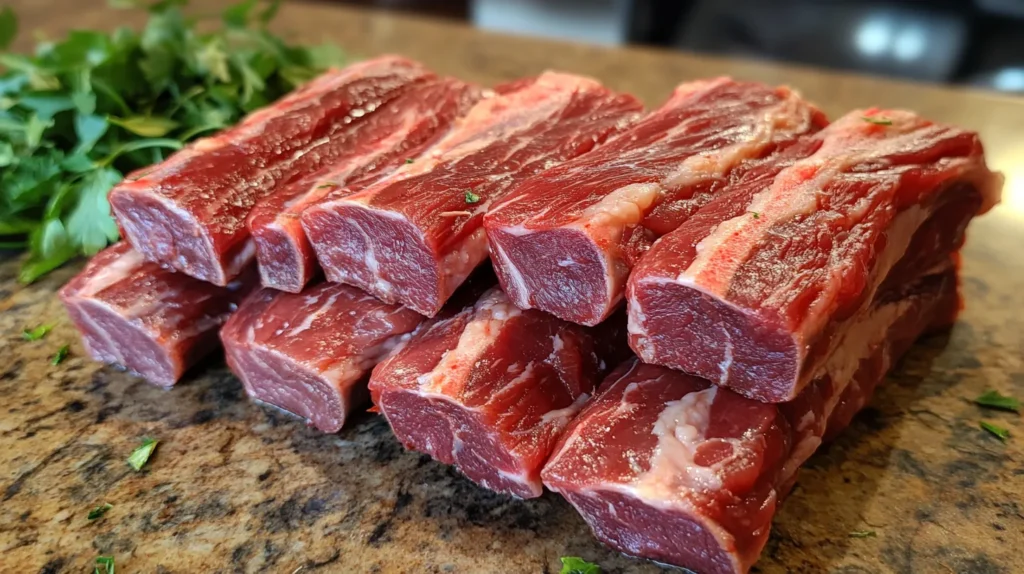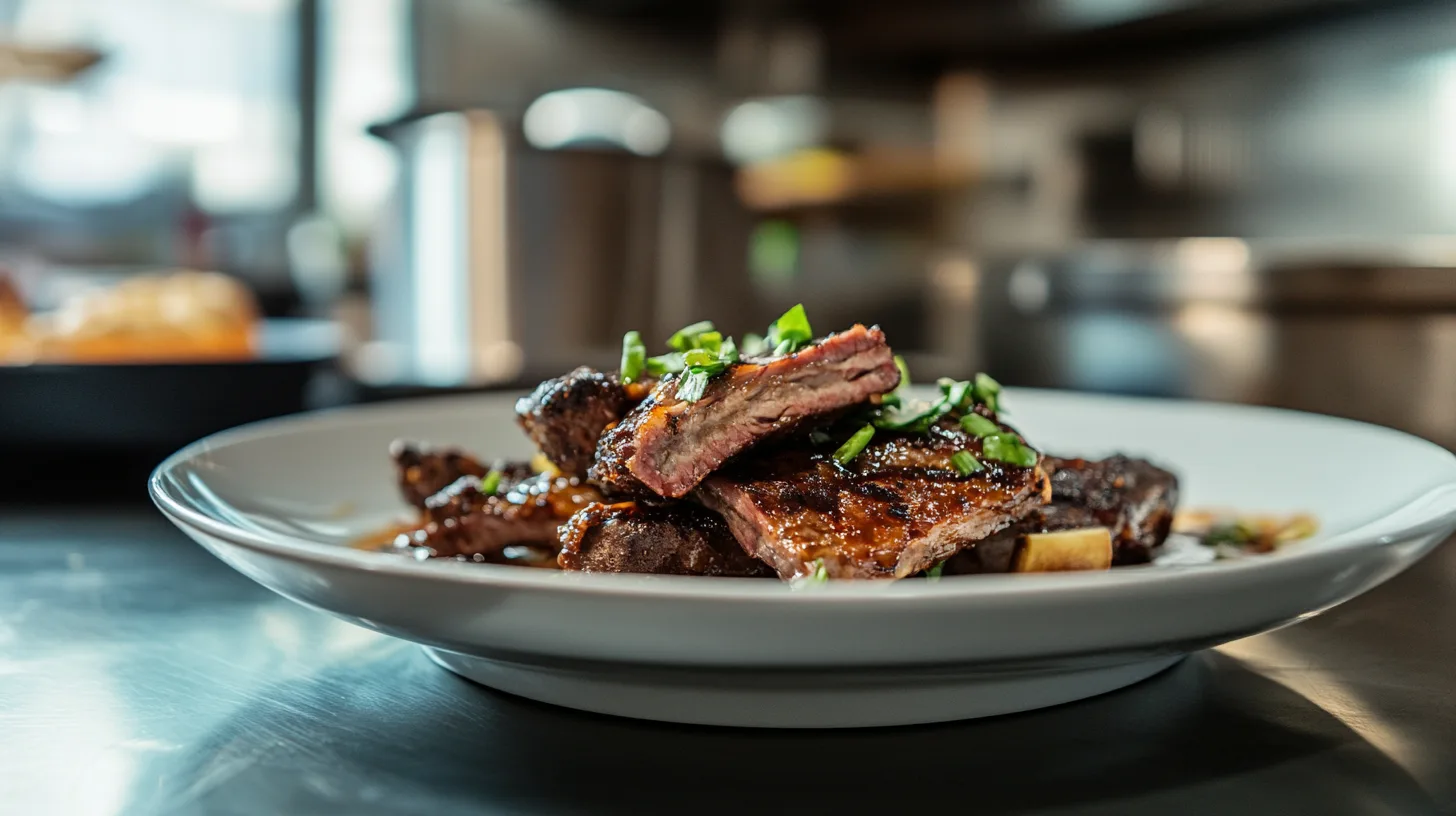Boneless beef ribs are a delicious, versatile choice for meat lovers, perfect for those who love the flavor of ribs without dealing with bones. Whether you’re slow-cooking them to achieve that tender, fall-apart texture or grilling for a smoky char, this guide will teach you everything you need to know about making the best boneless beef ribs.
What exactly are boneless beef ribs? Contrary to their name, Meat cuts don’t actually come from ribs. Instead, they’re typically derived from the chuck or short ribs area of the cow. The result? A rich, flavorful cut that’s ideal for slow cooking or marinating.
Table of contents
What Are Boneless Beef Ribs?
Boneless beef ribs are a meaty, versatile alternative to traditional bone-in ribs, offering a satisfying combination of rich flavor, tender texture, and convenience. Unlike their bone-in counterparts, Tender ribs provide more usable meat, making them a popular choice for home cooks who want to maximize their yield and avoid dealing with bones. These ribs are ideal for slow cooking, grilling, or oven roasting, as their structure and marbling allow them to absorb flavors and remain tender.
Where Do Boneless Beef Ribs Come From?
Although their name might suggest otherwise, boneless beef ribs don’t come from the rib section of the cow. Instead, they are typically sourced from other flavorful areas:
- Chuck or Shoulder Area: The shoulder region provides a cut prized for its visible marbling, which enhances juiciness and flavor during cooking. This area delivers a naturally rich and beefy taste, making it an excellent choice for hearty, slow-cooked dishes.
- Short Ribs: Butchers often craft boneless ribs by trimming the bones from short ribs. This process leaves behind a dense, flavorful chunk of pure meat, perfect for cooking methods that break down connective tissue and create a melt-in-your-mouth texture.
By removing the bone, these cuts become easier to prepare and eat while retaining their classic beefy essence. This makes boneless beef ribs a favorite for dishes that call for generous servings of tender, saucy meat.
Why Choose Boneless Beef Ribs?
Boneless beef ribs are incredibly versatile, making them suitable for a wide variety of recipes and cooking techniques. Their higher meat-to-fat ratio compared to other cuts ensures that they deliver both value and flavor. Whether you’re preparing a comforting slow-cooked meal or firing up the grill for a summer barbecue, boneless beef ribs provide a reliable and flavorful option.
Choosing and Preparing Boneless Beef Ribs
Selecting the right cut of boneless beef ribs is the foundation of creating a flavorful and tender dish. The quality of the meat you choose will significantly impact the final result, so it’s worth taking the time to pick carefully. Here’s what to keep in mind:
Even Marbling
Look for boneless beef ribs with visible fat streaked throughout the meat. This marbling ensures the ribs stay juicy and tender during cooking, as the fat melts and infuses the meat with flavor. Avoid cuts that appear overly lean, as they are more likely to become dry or tough. Good marbling is particularly important for slow-cooking methods, which rely on fat to enhance the texture and taste.
Uniform Sizes
Uniformity is key for even cooking. When all pieces of meat are similar in size and thickness, they will cook at the same rate, preventing some from being overdone while others remain undercooked. This is especially important when grilling or roasting, where precise timing is essential to avoid drying out smaller pieces.
Alternatives
If Beef ribs are unavailable, don’t worry—you can achieve a similar result with a well-trimmed chuck roast. The chuck cut comes from the shoulder area of the cow and has a similar rich, beefy flavor profile. To use chuck as a substitute, cut it into rib-sized pieces and prepare it in the same way. This option can also be more budget-friendly, offering an economical way to enjoy a hearty rib-like meal.
By carefully choosing and preparing your boneless ribs, you set the stage for a dish that’s full of flavor, perfectly tender, and a joy to eat. Whether you’re grilling, baking, or slow-cooking, starting with the right cut makes all the difference!

Cooking Boneless Beef Ribs: Methods for Perfection
Cooking boneless beef ribs is all about technique. Here are the three most popular methods:
1. Oven-Baked Boneless Beef Ribs
The oven is the go-to for a slow-cooked, melt-in-your-mouth texture:
- Preheat to 300°F.
- Season ribs with salt, pepper, and your choice of spices.
- Add a tangy BBQ sauce.
- Bake covered for 2–3 hours, flipping halfway.
2. Grilled Boneless Beef Ribs
For a smoky flavor:
- Marinate ribs for at least 4 hours.
- Grill on medium heat for 15–20 minutes, turning frequently.
- Baste with BBQ sauce during the final minutes for caramelization.
3. Slow Cooker Method
For a hands-off approach:
- Sear ribs in a pan to lock in flavor.
- Add ribs and sauce to a slow cooker.
- Cook on low for 6–8 hours or until tender.
Flavor Profiles: Elevating Boneless Beef Ribs
Seasoning and Marinades
Enhancing your meat cuts means finding the perfect balance of flavors:
- Sweet BBQ: Brown sugar, honey, or molasses.
- Spicy Kick: Add cayenne pepper or sriracha.
- Smoky Depth: Liquid smoke or smoked paprika.
Marinating overnight amplifies the flavor, ensuring every bite is infused with deliciousness.
Pairing Sides
Complete your meal with classic accompaniments:
- Creamy mashed potatoes.
- Tangy coleslaw.
- Sweet cornbread.
Avoiding Common Mistakes
- Overcooking: Leads to tough, dry meat.
- Skipping Rest Time: Resting the meat after cooking locks in the juices.
- Not Searing Before Slow Cooking: Searing creates a caramelized crust that enhances flavor.
Storing and Reheating Leftovers
Got leftovers? Here’s how to keep them tasting fresh:
- Refrigeration: Store in an airtight container for up to 5 days.
- Freezing: Wrap tightly and freeze for up to 3 months.
- Reheating: Add a splash of beef stock to prevent drying out when warming in the oven or on the stovetop.
FAQs About Boneless Beef Ribs
Are boneless beef ribs the same as short ribs?
Not quite. While beef ribs and short ribs share some similarities, they are distinct cuts. Tender ribs are typically trimmed from the chuck or shoulder area, or occasionally from the short ribs section with the bone removed. These cuts provide a dense, meaty texture and are more convenient to cook and serve. On the other hand, traditional short ribs are bone-in cuts, often taken from the plate or rib section of the cow, and include a significant amount of connective tissue surrounding the bone. Short ribs tend to have a slightly richer flavor due to the bone, but boneless ribs offer more meat per serving and are easier to prepare.
Can I cook boneless beef ribs in an air fryer?
Yes, you can absolutely cook boneless ribs in an air fryer, and it’s a great option for a quick and flavorful result. To prepare, preheat your air fryer to 375°F. Season the ribs with salt, pepper, and your choice of spices or marinade. Arrange the ribs in a single layer in the air fryer basket to ensure even cooking. Cook for about 20 minutes, flipping the ribs halfway through to achieve an evenly browned exterior. The high heat of the air fryer helps create a crispy, caramelized crust, while the interior remains tender and juicy. Just be mindful not to overcrowd the basket, as this can prevent proper air circulation.
What’s the best way to tenderize tough ribs?
If your boneless beef ribs turn out tough, they likely need more tenderizing before cooking. The best way to tenderize tough ribs is by marinating them overnight with an acid-based marinade. Ingredients like vinegar, citrus juice (such as lemon or lime), or buttermilk work effectively to break down the fibers in the meat. Adding aromatics like garlic, onion, and fresh herbs to the marinade can further enhance the flavor. For extra tenderness, you can also use a meat mallet to lightly pound the ribs before marinating. Once tenderized, cook the ribs using a low-and-slow method to ensure they become juicy and fork-tender.
How long should I marinate boneless beef ribs?
The ideal marinating time for boneless beef ribs depends on the flavor intensity you want to achieve, but for maximum impact, aim to marinate them overnight. A minimum of 4 hours is recommended to allow the marinade’s flavors to penetrate the meat and start breaking down the fibers for tenderness. If you’re short on time, even 1–2 hours can still add some flavor, but the longer the marinating time, the better the results. Just make sure to marinate the ribs in the refrigerator in a sealed container or bag to maintain food safety and freshness. After marinating, pat the ribs dry before cooking to ensure a good sear or caramelization.
Are Boneless Beef Ribs the Same as Short Ribs?
Not exactly. While they share some similarities, there are key differences. Boneless ribs are usually cut from the chuck or shoulder area, with the bone removed to create a meatier portion. In contrast, short ribs are bone-in cuts taken from the same general region or the plate section of the cow. Bone-in ribs often provide a richer flavor due to the bone, but the boneless variety is more convenient to prepare and yields more edible meat.
What is the preferred cooking method for boneless beef ribs?
The best cooking method depends on the desired result, but slow cooking is widely regarded as the preferred method. Whether baked in the oven, braised, or prepared in a slow cooker, the low-and-slow approach helps break down the connective tissues, resulting in tender, juicy meat. Grilling is another excellent option for those seeking a smoky flavor and caramelized exterior, but it requires careful monitoring to prevent the meat from drying out.
Why are my boneless beef ribs tough?
Tough boneless beef ribs are usually the result of insufficient cooking time or high cooking temperatures. This cut contains connective tissue that needs to break down slowly during cooking. If cooked too quickly, the meat will become chewy and difficult to eat. To avoid this, cook the ribs at a low temperature for an extended period, and ensure you allow them to rest before serving to lock in the juices.
Can you cook boneless beef ribs like a steak?
While possible, boneless beef ribs are best suited for slow cooking. For a quick and tender protein, explore our guide to Beef Tendon, which shares tips for tenderizing tougher cuts.
What’s the best way to store leftovers?
Store cooked ribs in an airtight container in the fridge for up to five days. For reheating tips, borrow ideas from the Forgotten Chicken Recipe to keep the meat juicy and flavorful.
Conclusion
Boneless beef ribs are a versatile, flavorful option that’s perfect for any occasion, whether you’re hosting a family barbecue or preparing a comforting slow-cooked meal. By following the tips and techniques in this guide, you’ll achieve tender, delicious results every time.
🌟 Stay Connected: For more recipes, cooking tips, and inspiration, be sure to follow us on Facebook. We’d love to see how your boneless beef ribs turn out don’t forget to share your creations with us!

